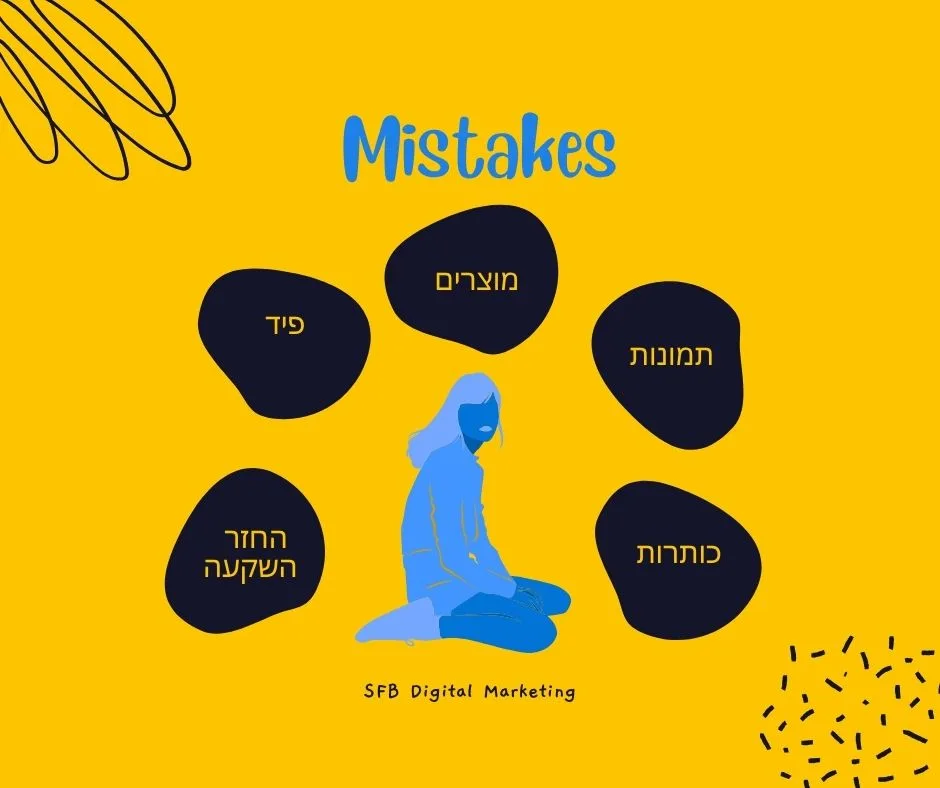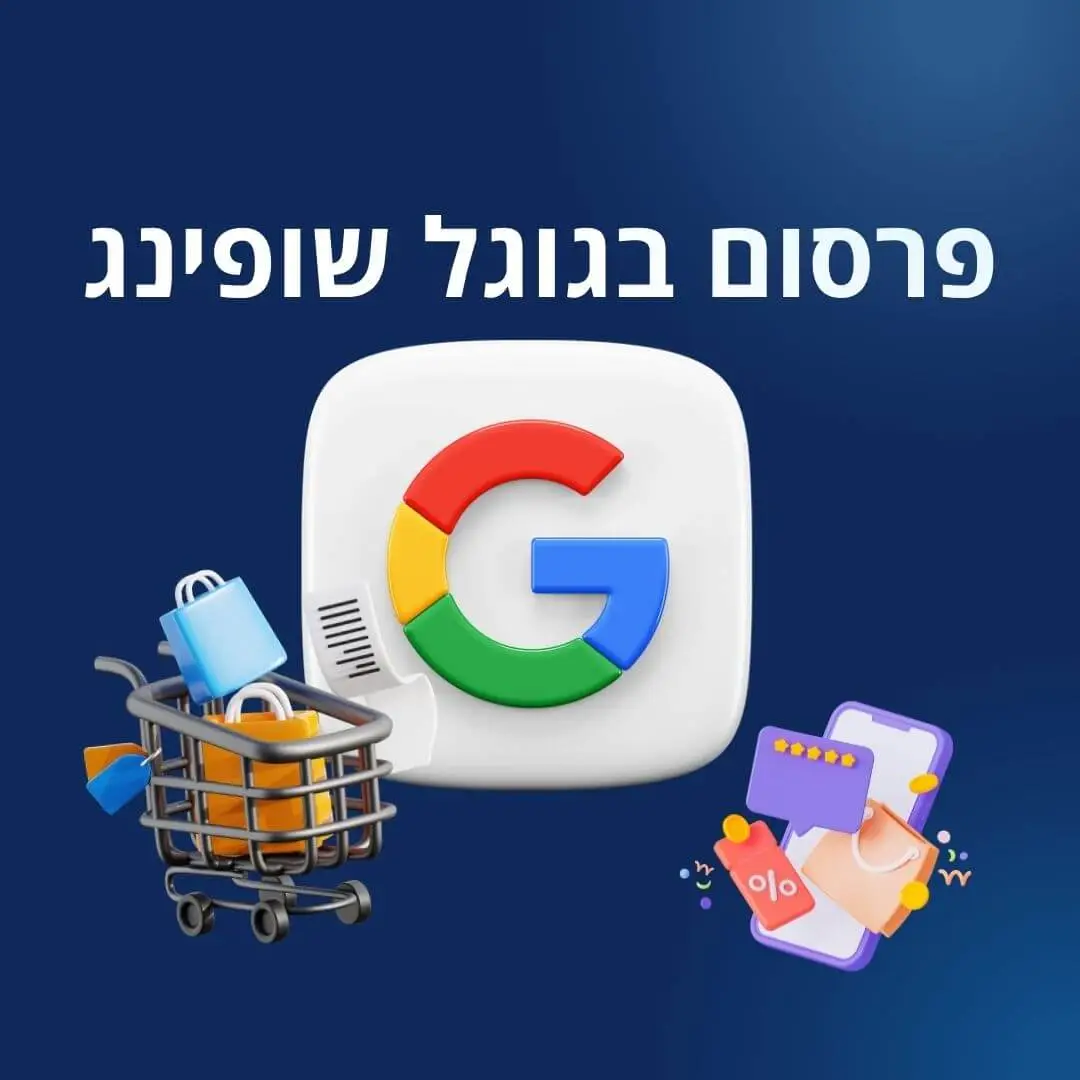
Contact
Contact
SFB is an advertising agency with a team of experts only, we provide advertising services for ecommerce sites that do not compromise on results and profit line, with a clear strategy and campaigns that will only make your business grow.
We always strive to be the best, the most professional, with excellent performance, personal attitude and a high level of customer service. Most importantly an amazing team that has only one goal - that your site will grow consistently and be profitable.
We will build Shopping campaigns for your website to maximize ROI.
We will analyze the status of your account from a
We will make sure that the advertising budget yields the highest profitability
And we will significantly improve your conversion rate.

Nice to meet you, Ani Shi, founder of SFB — an advertising agency specializing in eCommerce websites in Israel and sand and data-driven growth.
We're not talking about “clicks” -- we're measuring ROAS, CPA AND AOVCheck out what really drives your profit.
At SFB, we work with brands, companies and marketing teams who understand advertising — but want to reach the next level: Accurate performance, budget control, and funnels that produce a result.
We're not into miracles. We build a process, base decisions on data, And bring a result that you see in the profit line.
.avif)
.jpg)




.jpeg)
.jpg)

.jpg)











.jpg)
.png)
















.png)

.jpg)


Shay Cohen, founder and CEO of SFB Digital Marketing.
Icomers, Shopify, and more has been living and breathing for over 10 years, specializing in building data-driven performance strategies for brands, companies and startups in Israel and around the world.
Established the SFB with a clear goal:
Build a results-focused agency — one that understands budgets, knows how to interpret data, and manages advertising moves that generate accurate ROAS and don't click on the name of the report.
Shi personally leads the strategic directions of our key clients, a full partner in the planning and thinking behind every move, and leaves no campaign until it delivers results.
If you're a brand looking for a true performance partner — not just an agency to manage your budget —
You will feel the difference from the first conversation.

Even experienced advertisers fall for basic mistakes that sabotage performance. Here are some of the most common landmines -- and how to avoid them.



Starting from market analysis, audience, business model and competition.
Only after we understand the business and the goals -- we build the course of advertising.

We pre-define success metrics: ROAS, CPA, AOV, conversion rate, and more.Because without a target — you can't be precise.

Build custom campaigns — from the audience to the creative.There are no temples. There is a smart advertising setup that is connected to the goals.
Custom Live Dashboard, monthly reports, continuous communication with the campaign manager.
You don't guess what's going on, you see it.
They don't rest on numbers. Test, improve, restore successes and reduce waste.
The goal is not to produce a campaign -- but to generate profit.
We're connected to every system -- Google, Meta, GA4, CRM -- so you can know what works and what doesn't.
No guesswork. Just analysis that leads to decisions.
You are in direct contact with whoever is actually running the campaign. Not a service center. Not “client manager”. Only those who know, do, and bring a result.
We are available in shared chat. You don't have to wait for an email or an appointment. There is direct contact with the staff.
You get a live monitoring system. Every click, every conversion, every pound — is reported in real time.More than once a month. Not with delays.
Beyond organized reports, you'll find analyses, ideas, recommendations and business understandings.Because in the end, it's not just advertising — it's strategy.
Unlike advertising on Google, where the bulk of the work is concentrated on creating campaigns, including defining keywords, drafting ads, using plugins, etc., advertising on Google Shopping works in a slightly different configuration.
In Google Shopping you are not required to define keywords, nor to draft ads. All you have to do is enter the products in the Google Merchant Center. Google Merchant Center is, in fact, the place where you manage the products themselves, including the price, image, and brief description in the headlines. At the same time, the campaign itself, including the date settings, prices, and other settings that relate to the advertising process rather than the products themselves, will be managed by Google Ads.
So, in practice, a campaign on the Google Shopping service, is run in two separate places: Google Merchants Center to manage the products themselves, and Google Ads to manage the campaigns themselves.

A platform that allows you to enter your product information so that Google can display it in shopping ads.
An automated file or connection that transmits product information (name, price, image, etc.) to Google Merchant.
A unique identifier for each product in the feed — essential for optimization and performance tracking.
A standard product code that Google uses to identify products and improve matching.
Price for each click you paid.
THE PRODUCT TITLE THAT APPEARS IN THE AD — IT IS IMPORTANT THAT IT IS CLEAR, DESCRIPTIVE AND INCLUDES KEYWORDS.
Internal category that you set up to organize your products (not the same as Google's category).
Custom labels that allow you to mark product groups by seasons, profit margin, promotions, etc.
Value of conversions obtained from the product — used to measure return on investment (ROAS).
An index that shows how much income was received from each shekel invested in advertising.
A smart hand strategy that tries to raise or lower the hand according to the likelihood of conversion.
A campaign that combines Shopping, Search, YouTube, Discovery and more ads — with concentrated performance.

The goal of the campaign is that you, the business owners or those who trust the campaign, need a minimum of work to maintain it.
But make no mistake! Just because it is smart shopping does not mean that it is smart and that anyone can set it up professionally! There is a neat way to set up smart shopping with a hierarchy that will maximize results and return your investment as much as possible.
THE PMAX CAMPAIGN (PERFORMANCE MAXIMIZATION CAMPAIGN AS GOOGLE CALLS IT IN HEBREW), IS A RELATIVELY NEW CAMPAIGN THAT GIVES ADVERTISERS THE ABILITY TO ADVERTISE ALL GOOGLE ADS ADVERTISING SPACES AND ALL FROM ONE CAMPAIGN.
The PMAX campaign is marketed in advertising spaces such as: YouTube, the media network, the search network, the Discovery campaign, Gmail, and Google Maps.
In this kind of campaign we get our hands dirty:), literally everything is manual and controllable.
Whether it's the audiences we choose to advertise to, the products we want to showcase, what hand we want to put on each product according to its competition, and more.
The question arises, why should you advertise on Google Shopping at all, and what is the advantage of advertising on the service on top of that in Google Ads. The answer is that advertising on the Google Shopping service generates several relative benefits:
In some cases, advertising on Google Ads does not allow small businesses to face the competition environment. Article click-through prices, and overly aggressive pricing, make small businesses realize that this advertising channel can't leave them with a profit in some cases.
Advertising on Google Shopping is based on matching the product to the search performed by the customer. In this way, even small businesses that do not have a very high advertising budget can, with proper work, expose their products to the appropriate target audience.
Advertising on Google Shopping does not require entering keywords or wording ads. In the advertising process, Google makes a comparison of the user's search with product titles and descriptions, as well as the asking price.
In such a work configuration, businesses characterized by the great dynamism of the goods offered to customers, entering the inventory of new products and the exit of other products from the inventory, can benefit from the management of relatively stable campaigns, one in which no resources need to be spent every time a product is changed, other than the feed of the new product to the Google Merchants Center.
Another significant advantage offered by the Google Shopping service is the display of products on the pages of search results.
First, Google Shopping results appear at the top of the search results page, and can be viewed both laterally and longitudinally (if you select the appropriate tab for shopping in search results).
Second, unlike ads on the Google Ads service that are shown with a sign that it is a sponsored promotion, it is much more difficult for Google Shopping to understand that it is sponsored advertising. This configuration makes it easier for users to make a call decision in front of the business, because the search results seem more natural, accurate, and more objective.
In addition, clicking on an ad in the Google Shopping service, will lead the surfer to the product and sale page itself, which will allow skipping over unnecessary landing pages, depending on the customer's search intent.
The fact that Google accesses the important information to the customer (image and price) already on the search results page provides a much better usage experience from the customer's point of view.
Google Shopping allows you, the advertisers, to take Remarketing advertising actions that allow ads to be redisplayed to customers who have already searched for the product. Also, Google Shopping will allow you to perfect the targot in customers, and focus on cart abandoners, customers looking for similar products, etc.
Dynamic remarketing advertising all the more leads to amazing results as it appears in the eyes of hot surfers who were quite recently on your site but abandoned for some reason.
Google Shopping, like other advertising channels, allows you to manage and build audiences — and then target those audiences with different campaigns. The idea behind this method is the assumption that if a campaign worked well in front of a defined audience and domain, there is a high probability that similar campaigns presented to similar audiences will also work well.
In the new PMAX campaign, this is called a crowd signal. Audience Signal allows you to add remarketing audiences, interests, demographic settings of your target audience, and more filters and add-ons to help the Google Ads algorithm show your ads to the right audience for your business.
You can, of course, connect Google Shopping to Google Analytics, in order to track the visitors who visit and view your products, analyze the traffic and abandonment of users, and improve the way your products are presented to the target audience on Google. This way you can identify the ads that worked well and those that worked less well, during the campaign.
The connection to Google Analytics is done in a simple way through Google Analytics through the settings, so that once connected all the data of your campaigns will be shown to you in Analytics with all the important data.

You've set up a virtual store and you realize that Google advertising is one of the most important traffic sources for your business.

In this article we will talk about important parameters that must be taken into account when promoting a virtual store in order to successfully bring customers

Google Merchant is a free Google tool that helps online businesses display their products in Google search results, Google Shopping, and more.